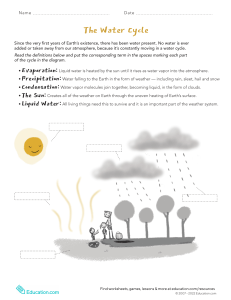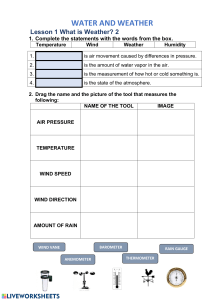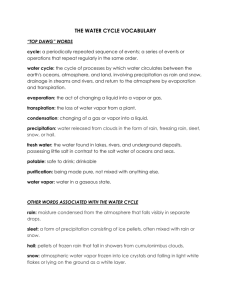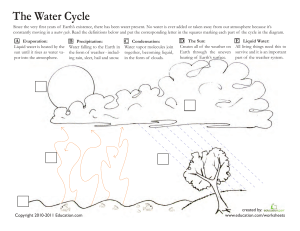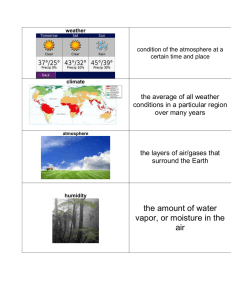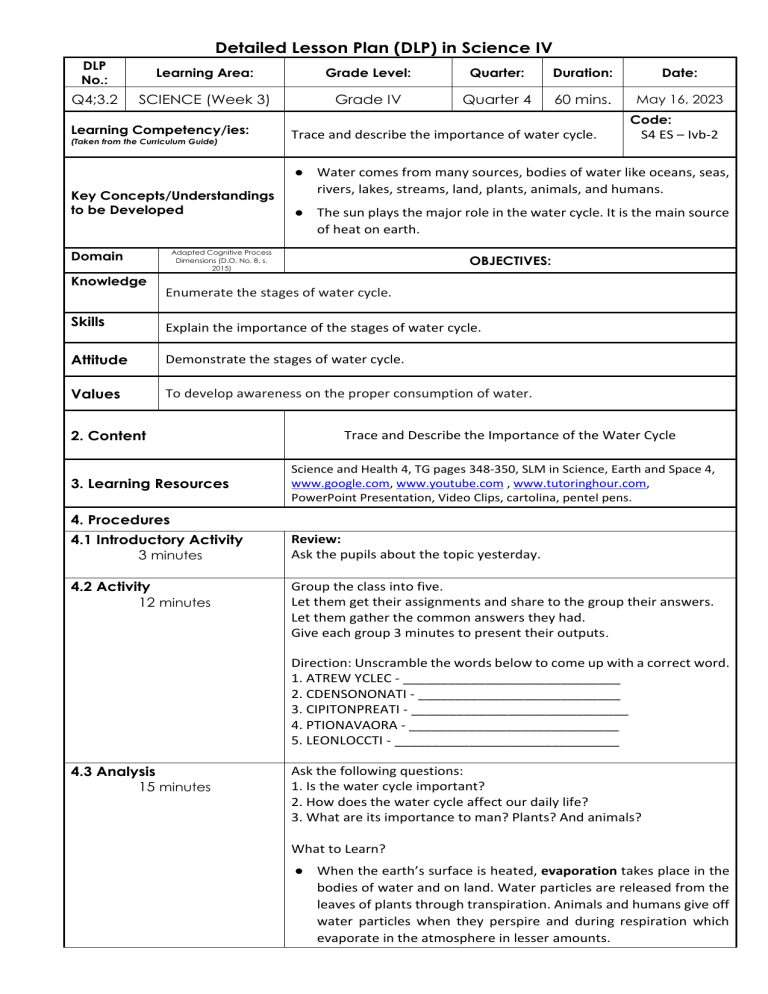
Detailed Lesson Plan (DLP) in Science IV DLP No.: Learning Area: Grade Level: Quarter: Duration: Date: Q4;3.2 SCIENCE (Week 3) Grade IV Quarter 4 60 mins. May 16, 2023 Learning Competency/ies: (Taken from the Curriculum Guide) Key Concepts/Understandings to be Developed Domain Knowledge Code: Trace and describe the importance of water cycle. S4 ES – Ivb-2 ● Water comes from many sources, bodies of water like oceans, seas, rivers, lakes, streams, land, plants, animals, and humans. ● The sun plays the major role in the water cycle. It is the main source of heat on earth. Adapted Cognitive Process Dimensions (D.O. No. 8, s. 2015) OBJECTIVES: Enumerate the stages of water cycle. Skills Explain the importance of the stages of water cycle. Attitude Demonstrate the stages of water cycle. Values To develop awareness on the proper consumption of water. 2. Content 3. Learning Resources Trace and Describe the Importance of the Water Cycle Science and Health 4, TG pages 348-350, SLM in Science, Earth and Space 4, www.google.com, www.youtube.com , www.tutoringhour.com, PowerPoint Presentation, Video Clips, cartolina, pentel pens. 4. Procedures 4.1 Introductory Activity 3 minutes Review: Ask the pupils about the topic yesterday. 4.2 Activity 12 minutes Group the class into five. Let them get their assignments and share to the group their answers. Let them gather the common answers they had. Give each group 3 minutes to present their outputs. Direction: Unscramble the words below to come up with a correct word. 1. ATREW YCLEC - _____________________________ 2. CDENSONONATI - ___________________________ 3. CIPITONPREATI - _____________________________ 4. PTIONAVAORA - ____________________________ 5. LEONLOCCTI - ______________________________ 4.3 Analysis 15 minutes Ask the following questions: 1. Is the water cycle important? 2. How does the water cycle affect our daily life? 3. What are its importance to man? Plants? And animals? What to Learn? ● When the earth’s surface is heated, evaporation takes place in the bodies of water and on land. Water particles are released from the leaves of plants through transpiration. Animals and humans give off water particles when they perspire and during respiration which evaporate in the atmosphere in lesser amounts. ● When water vapor in the atmosphere has cooled, condensation process takes place. The condensed water vapor is transported and moved from one location to another in the atmosphere. Where the condensed water vapor becomes heavy, it falls back to the earth in the form of rain, hail, snow, and sleet, this is called precipitation. ● When water falls back to the earth, it goes back to the bodies of water, and it may end up on land. When it ends up on land, it will become a part of ground water that animals and humans, including plants, can use, or it may run over the soil and collect it in the oceans, lakes, rivers where the cycle starts all over again. The water continues this cycle. 4.4 Abstraction 12 minutes Contextualization: Liquid water evaporates into water vapor, condenses to form clouds and precipitates back to earth in the form of rain and snow. Water in different phase moves through the atmosphere. Show again the water cycle process. The teacher will discuss the importance of the water cycle. The water cycle is crucial because it determines how water gets to us, plants, and animals. In addition to providing water for people, animals, and plants, it also transports nutrients, diseases, and sediment into and out of aquatic habitats. 4.5 Application 10 minutes Group Activity: Demonstrate the stages of water cycle through graphic organizer. 4.6 Assessment 5 minutes Write True if the statement is correct and False if it is incorrect. ______ 1. The water will stop when it is dropped as a form of rain. ______ 2. Evaporation takes place in the bodies of water and on land. ______ 3. Only animals give off water particles. ______ 4. Water cycle is not important. ______ 5. Where the condensed water vapor becomes heavy, it falls back to the earth in the form of rain, hail, and snow. 4.7 Assignment 2 minutes Enhanci ng/Impr oving the day’s lesson 4.8 Concluding Activity 1 minute Draw the water -cycle stages. The water cycle shows the continuous movement of water within the Earth and atmosphere. 5. Remarks 6. Reflections A. No. of learners who earned 80% in the evaluation B. No. of learners who require additional activities for remediation E. Which of my learning strategies worked well? Why did this work? F. What difficulties did I encounter which my principal or supervisor can help solve? G. What innovation or localized materials did I use/discover which I wish to share with other teachers? Water cycle determines how water gets into living things. C. Did the remedial lessons work? No. of learners who have caught up with the lesson. D. No. of learners who continue to require remediation. Prepared by: Name: School: Position/Designation: Division: MANDAUE CITY Contact Number: Email address:
